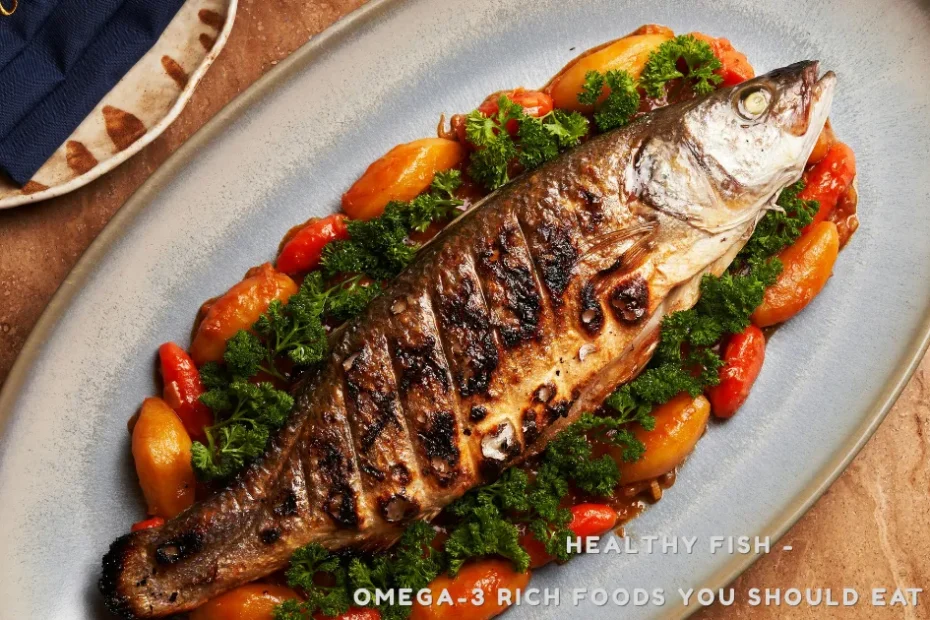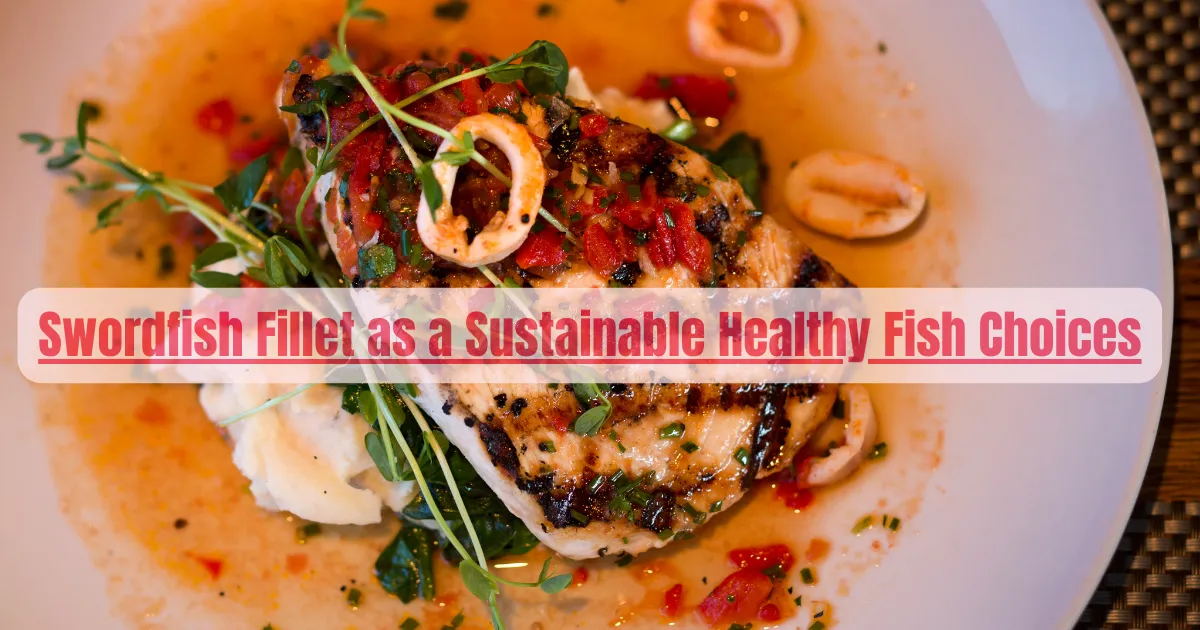Low-Mercury Fish: Are you looking for sustainable and healthy fish choices to incorporate into your diet? Swordfish fillet is a delicious and versatile option that is good for you and the environment. Whether grilled, baked, or pan-seared, swordfish can be a flavorful addition to any meal.
This article will explore the benefits of choosing sustainable swordfish and provide some delicious recipes for home cooking. From lemon herb swordfish skewers to spicy swordfish tacos, there are plenty of tasty ways to enjoy this nutritious and eco-friendly fish.
So, if you want to make more environmentally-conscious food choices without sacrificing flavor, learn more about sustainable, healthy fish choices and discover some mouth-watering swordfish recipes.
How to Choose Sustainable and Healthy Fish
In addition to being a good source of protein and fat, some types of fish are rich sources of specific vitamins and minerals. For example, oily fish contain large amounts of Vitamin D (which helps regulate bone health), and lean white meat contains high levels of Vitamin B12 (necessary for blood formation and cell growth) and selenium (an antioxidant that promotes thyroid function and helps prevent cancer).
Fish has been linked to numerous health benefits, ranging from supporting heart health and reducing the risk of cardiovascular diseases to protecting against cognitive decline and Alzheimer’s disease.
In this article, we’ll dive into sustainable and healthy seafood. We’ll explore what makes a seafood option sustainable and healthy, and provide some tips on choosing the best options when you’re at the grocery store or dining out. By the end of this article, you’ll be equipped with the knowledge to make more informed and responsible seafood choices.
It is well known that fish support brain development, improve memory, and even boost mood.
Sustainable Fish: Making Eco-Friendly Seafood Choices & Healthy Fish
Sustainable fish, often labeled as eco-friendly seafood, are the products of responsible fishing and aquaculture practices. These choices are not only delicious but also environmentally responsible. Here’s what you need to know about sustainable fish:
What Is Sustainable Fish?
Sustainable fish come from sources that prioritize the long-term health of fish populations, aquatic ecosystems, and the livelihoods of fishing communities. These practices aim to prevent overfishing, minimize environmental impact, and support healthy oceans.
Critical Characteristics of Sustainable Fish:
Abundant Populations: Sustainable fish species are plentiful, ensuring their populations thrive even with fishing activities.
Responsible Fishing Methods: Eco-friendly fishing methods, such as pole-and-line, troll, and trap fishing, reduce bycatch and minimize damage to ocean habitats.
Well-Managed Aquaculture: Sustainable aquaculture operations follow strict environmental standards, such as minimizing antibiotic use and waste production.
Traceability: You can trace the journey of sustainable fish from source to plate, ensuring transparency and legality.
Certifications: Look for labels like MSC (Marine Stewardship Council) and ASC (Aquaculture Stewardship Council) certifying sustainable seafood.
Low Mercury Levels: Some fish species are naturally lower in mercury, making them safer for regular consumption.
Local and Seasonal Choices: Opting for locally sourced and seasonal fish supports nearby communities and reduces the carbon footprint associated with long-distance transport.
Why Choose Sustainable Fish?
Preserve Ocean Health: Sustainable choices protect marine ecosystems, maintaining biodiversity and the balance of ocean life.
Combat Overfishing: Avoiding overfished species will help prevent further decline in fish populations.
Support Fishing Communities: Sustainable practices benefit fishing communities by ensuring stable livelihoods and access to fish stocks for future generations.
Health Benefits: Low mercury levels and responsible sourcing make sustainable fish safer and healthier for you and your family.
Nutritional Benefits of Consuming Fish (Healthy Fish)
Fish is a fantastic source of nutrition. It’s rich in omega-3 fatty acids, essential for heart health, brain function, and reducing inflammation. Fish is also packed with high-quality protein that helps build and repair tissues, making it a great addition to your diet.
Risks of Contaminated Fish
However, it’s essential to be aware that not all fish are created equal. Some fish can contain mercury or other pollutants, which can be harmful if consumed in large amounts. Mercury is a heavy metal that can affect the nervous system, particularly in young children and pregnant women.
🐟 Choosing Low-Mercury Fish for a Healthier You
When it comes to eating seafood, choosing low-mercury fish is one of the smartest moves you can make for your health. Mercury is a toxic heavy metal that can accumulate in the body over time, potentially leading to serious health issues—especially for pregnant women, young children, and those who consume fish frequently.
The good news? Not all fish are created equal when it comes to mercury content. Smaller species and those lower on the food chain tend to have significantly less mercury than larger, predatory fish. That means you can still enjoy the nutritional benefits of seafood—like omega-3 fatty acids, lean protein, and essential vitamins—without the added risk.
Some of the best low-mercury fish options include:
- Salmon – Rich in omega-3s and widely available.
- Sardines – Packed with calcium and heart-healthy fats.
- Trout – Mild flavor and great for grilling or baking.
- Anchovies – Tiny but mighty in nutrients.
- Shrimp – Low in mercury and high in versatility.
- Tilapia – Affordable and easy to cook.
In contrast, fish like tuna, swordfish, shark, and king mackerel tend to have higher mercury levels due to their size and lifespan. These should be consumed sparingly, if at all.
Incorporating a variety of low-mercury fish into your diet not only reduces your exposure to harmful contaminants but also ensures a broader intake of nutrients. Whether you’re meal prepping, dining out, or shopping for groceries, keep this list in mind to make safer, smarter seafood choices.
Your body—and your taste buds—will thank you.
Healthy Fish Choices
Fish Calories per Serving Calculator
Healthy Fish Calorie Calculator
Are you trying to watch your calorie intake but still want to enjoy a delicious fish dinner? It can be difficult to know how many calories you’re consuming when it comes to fish, as different types of fish have different calorie counts. But don’t worry, there’s a solution!
Fish Calorie Calculator – a tool that helps you determine the calorie count of different types of fish. With this tool, you can make informed decisions about your food choices and ensure you stay within your calorie goal.
We’ll take a closer look at the Fish Calorie Calculator, how it works, and how you can use it to make healthier choices when it comes to your seafood meal
Which Fish Is Best for Your Diet? A Side-by-Side Comparison
| Seafood | Omega-3 Fatty Acids(per 100g) | Protein(per 100g) | Mercury Level | Key Nutrients | Health Benefits | Health Risks |
|---|---|---|---|---|---|---|
| Sardines | High (~1.5–2g) | High (~25g) | Low | Vitamin D, B12, calcium, selenium | Heart health, bone strength, anti-inflammatory, good for weight loss | Sodium in canned varieties |
| Anchovies | High (~1.5g) | High (~29g) | Low | Niacin, selenium, calcium, iron | Supports metabolism, brain and bone health | Often very salty; can raise blood pressure |
| Swordfish | Moderate (~0.6g) | High (~20g) | Very High ⚠️ | Selenium, B12, niacin | Lean protein, supports energy and thyroid | High mercury risk, not safe for pregnant women |
| Trout | High (~2g) | High (~20g) | Low | B12, niacin, potassium, vitamin D | Brain health, reduces inflammation, supports heart | Generally safe; farmed varieties may contain contaminants |
| Mackerel | Very High (~2.5g) | High (~19g) | Varies (Low–Moderate) | Vitamin D, B12, selenium | Lowers triglycerides, anti-inflammatory, brain support | Some types (e.g., king mackerel) high in mercury |
| Lobster | Low (~0.2g) | High (~19g) | Low | Zinc, copper, B12, phosphorus | Supports nerve function, immune health | High cholesterol; often cooked with butter/salt |
| Tuna | Moderate (~0.5–1g) | High (~23–25g) | Moderate to High ⚠️ | Selenium, B3, B6, B12 | Heart health, supports metabolism | Mercury concern (especially in albacore); choose light tuna more often |
How Much Protein Is in A Swordfish?
🐟 A 100-gram serving of swordfish contains approximately 19.5 to 26.7 grams of protein, depending on whether it’s raw or cooked:
Raw swordfish (100g): ~19.5g protein
Cooked swordfish (dry heat, 100g): ~26.7g protein
That makes swordfish a high-protein seafood option, great for muscle maintenance and overall nutrition.
Mercury in Swordfish: What You Should Know
Swordfish is indeed a high-protein fish, but it also ranks among the highest in mercury content. According to recent data:
- Average mercury level: ~0.995 ppm (parts per million)
- Maximum recorded level: up to 3.22 ppm
This places swordfish in the “high mercury” category, meaning it should be consumed sparingly, (Not Low-Mercury Fish_ primarily by:
- Pregnant or nursing women
- Young children
- Individuals with neurological sensitivities
💡 Why so high? Swordfish are large, long-lived predators. They accumulate mercury over time through a process called biomagnification, absorbing it from smaller fish they eat.
If you’re looking for safer alternatives with similar nutritional benefits but lower mercury, consider:
- Salmon (0.022 ppm)
- Sardines (0.013 ppm)
- Trout (0.071 ppm)
Source & Credits
What You Need to Know About Glycemic Index (GI)
Diabetic-Friendly Seafood: Nutritional Wonders Smart Choices
Best 9 Low-Glycemic Index Foods for a Diabetic-Friendly Diet
https://www.onemedical.com/blog/eat-well/healthy-fish-eating-guide/
https://www.prospre.io/blog/10-high-protein-fish-and-seafood
Share this:
- Click to share on Facebook (Opens in new window) Facebook
- Click to share on Pinterest (Opens in new window) Pinterest
- Click to share on LinkedIn (Opens in new window) LinkedIn
- Click to share on X (Opens in new window) X
- Click to share on Tumblr (Opens in new window) Tumblr
- Click to share on Bluesky (Opens in new window) Bluesky



Loving the focus on sustainable & healthy fish! What are your fave ways to prepare it? I’m all about simple lemon & herbs for that fresh flavor burst. Bonus points if you share a hidden gem recipe!
Sustainable fish choices are such a game-changer! It’s great knowing we can enjoy our favorite seafood while also caring for the environment.
Swordfish is a great source of lean protein and healthy fats. It has a low GI, meaning it doesn’t cause a significant spike in blood sugar levels.
Navigating diabetes management can be overwhelming, but understanding how different foods affect my blood sugar level through healthy nutrition has empowered me.